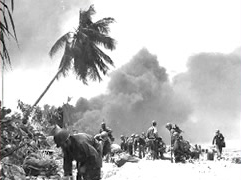12-18 February 1944
Allied seizure of the Marshall Islands
By 17 February 1944 a combined U.S. Army, Navy, and Marine amphibious task force had seized Kwajalein Atoll in the Marshall Islands, and had made a successful landing at Eniwetok to the north and west. The Nimitz-MacArthur “island-hopping campaign” that led to Allied victory in the Pacific was sustained by revolutionary supply techniques developed by the Quartermaster Corps.
 In the initial assault on Kwajalein, the 7th Infantry Division Quartermaster Company set up a virtual motor pool on water to quickly deliver ammunition, POL, rations, and other key items to combat units at the front. An armada of naval landing crafts (LSTs) brought dozens of amphibious DUKWs into the assault area on D-Day. There, too, on the swaying deck of subchaser 1066 was Lieutenant J. T. Dalton, QMC, with a 510 radio in hand serving as the supply control officer.
In the initial assault on Kwajalein, the 7th Infantry Division Quartermaster Company set up a virtual motor pool on water to quickly deliver ammunition, POL, rations, and other key items to combat units at the front. An armada of naval landing crafts (LSTs) brought dozens of amphibious DUKWs into the assault area on D-Day. There, too, on the swaying deck of subchaser 1066 was Lieutenant J. T. Dalton, QMC, with a 510 radio in hand serving as the supply control officer.
The LSTs were loaded in “drug store” fashion with a mixed cargo of supplies likely to be damaged. As infantry battalion supply officers called Lieutenant Dalton, he promptly relayed their message to the LSTs, and within minutes he could watch the DUKWs emerge from the ships’ holds, heading ashore.
The QM inspired “drug store” resupply system increased efficiency and prevented beach-jamming of shore party operations, and prompted like victories in the days ahead.
Compiled by Dr. Steven Anders, former Quartermaster School historian.
Quote of the Week:
I don’t know what the hell this ‘logistics’ is that [General] Marshall is always talking about, but I want some of it.— Attributed to Admiral Ernest J. King during World War II
